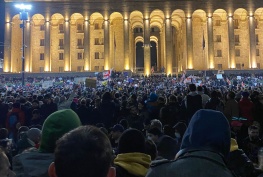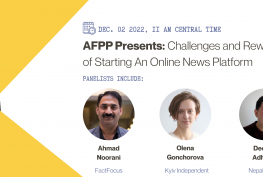By Emran Hossain
He stutters and cannot speak English fluently. Yet, whenever the 70-year-old man comes across a priest of the Vatican’s United States Embassy, he introduces himself: “My name is John Wojnowsky. What is your name?”
Wojnowsky cannot say how many times he’s asked that question in the last 15 years, when he has spent a part of each of his days, weekends and holidays included, in front of the Holy See’s diplomatic mission, known as Apostolic Nunciature, in Washington, D.C.
Not a single priest, he says, will give Wojnowsky his name, just as the Vatican’s U.S. envoys never have replied to the letter he sent in August, 1997. His letter seeks a church investigation of his claim that a Catholic priest overseas molested him when he was age 15.
Though the issue of Catholic clerics’ sexual abuse of children has dominated headlines across the Western world, resulted in giant settlements and won accolades for U.S. media organizations, Wojnowky waited more than six months for a reply to his letter. Then one morning he decided to picket the Washington embassy. That is how his one-man protest began.
The representatives of Rome, he says, reached out to this Polish-born American citizen once – but only to say that the priest he accused was dead and that meant that nothing further would occur with his case. A priest, who did not name that dead clerical colleague, also told Wojnowsky: “I will pray for you and the Embassy would pay for your therapy.”
Wojnowsky, in his blog, replied to the church’s proffer, asking: “Was a bishop’s prayer compensation for my loss (my and my family’s 39 years of suffering) the wasted potential of a ruined life on a cruel priestly joke?”
Though brief-lived protests are common at embassies around the U.S. capital, Wojnowsky’s vigil is distinctive and hard to pass by. It offers a glimpse into the workings of the Catholic church, the leading faith in America, and it provides a timely counterpoint for global visitors to too-easy Western attempts to reach sweeping conclusions about other nations and societies based solely on religion.
Wojnowsky always carries small scraps of paper with URLs for different blogs, including his own, dealing with priestly abuse. In a plastic bag, he’s armed only with flyers and copies of articles written about him. Those published pieces, painfully, note that he never has filed a formal claim nor sued the church over the incidents he says occurred in Europe. Instead, the retired iron-worker maintains his stead-fast vigil.
He speaks tirelessly for hours, discussing the same point, for his English is not good, and he wants anyone who talks with him to get him right. He goes on in interviews because he lacks faith in mainstream media, which, he says, obsess on irrelevant details or show bias for or are even supported in some way by the embassy. In his blog, Wojnowsky gives full, free rein to his thoughts and recollections of a life torn by what happened to him as a child.
“My personality was crushed in the bud, catastrophically and irrevocably damaged,” said Wojnowsky, who paces before the Vatican embassy with his 8-by-3-foot sign every afternoon from 4:30 to 8 at night.
Those inside the embassy largely ignore Wojnowsky, his passion and sufferings in his years’ long protest, uninterrupted by rain, snow and scorching sun. All Wojnowsky wants is to get church officials to listen to his story, recognize the damage done to the ”only life” he has had.
“I was so insecure, my personality changed .. . look changed … appearance changed … . I wasted my life … destroyed my wife … my kids suffered for me,” Wojnowsky said in broken words.
He says he avoided the company of people for 39 years, traveling overseas as a loner,from Italy to Canada, then to America. He abandoned his study, his parents and could not hold any job. He eventually married but his family time he says was nightmarish because of his childhood trauma. Now he lives alone, deserted and lonely.
Wojnowsky recalls that he was an eighth-grader on vacation in an Italian village when a Catholic priest took him to the rectory for lessons in Latin. Once there and alone, the priest immediately put his hands on his bare knees and told him to fondle himself while he watched. The priest bantered with him, the cleric suggesting at one point his own privates were “terrible,” even missing.
That chatter was the last that Wojnowsky could remember of being molested. Then suddenly he was outside the rectory. “The feeling was so terrible. It was dark. Outside the building, I saw nothing,” he said.
He considers his case “unique” because so short an encounter as a youth, he insists, damaged him for life. Based on psychoanalytic theory, especially its emphasis on the impact of sexual experiences in the young, it’s plausible to consider how the priest’s words and the traumatic incident created castration fears and Wojnowsky’s loss of identity as a man.
“I believe and can prove that this molestation was the crucial episode that altered negatively the course of my life and caused much suffering to me and to my family during the last 39 years,” Wojnowsky wrote in his first letter to the Archbishop of Washington. The missive concluded: “I welcome any interrogation by church officials and expert because I am confident that my claim will only be strengthened.”
On his blog, Wojnowsky tells how the embassy has sought to undercut him and his protest, including by seeking first to expose his identity in media reports, then through “threats” and “bullying.”
He early on did not identify himself because he feared his devout, elderly mother would be shamed and humiliated. But that all ended when a reporter, he says with church officials’ help, printed his name in 1998 when he first began his protest. “You cannot imagine how I was shocked … ! I thought about committing suicide, they expected me to do that,” he says.
Though he says priests have told him he would be subject to ignominy and one even spit on him, Wojnowsky has persisted in his cause – in person and online.
“They are weak, cowardly and make mistakes,” he says of those in the church who will not deal with him and others who say they were abused. Referring to Rome’s stance of the abolition of slavery and other matters, he says of Catholic leaders, “They were always on the wrong side of the history.”
In recent years, the Catholic church around the globe has been forced to deal with a mountain of claims of priests abusing children. The BBC, in a documentary, reported that the church allocated $700 million to settle such allegations in 1997, when they began to surface. The Boston Globe won a Pulitzer Prize for its reporting on how church leaders covered up clerical transgressions, transferring priests from parish to parish, even as they continued to harm children in the global community of 1.2 billion Catholic faithful.
The scandal has rocked the church across the United States and in Europe, particularly in Ireland. Abuse victims were forced to fight for years before the church, considered one of the world’s most powerful religious institutions, finally admitted to the damage done and offered compensation, which published reports say has hit a cost of $2 billion spent by the church to settle sexual abuse cases involving priests between 1950 and 2007.
As for Wojnowsky, he writes in his blog: “The monumental stupidity, ignorance and arrogance of the beyond-vile Catholic church’s response to my pleas cannot possibly be blamed on some obscure, inexperienced and ignorant village priest.”
Now a self-proclaimed agnostic, he says his one-man protest has taught him his life’s best lesson: the power of standing up for what he believes. He is no longer a loner but a protester and an online activist. He believes that corrosive secrecy can be defeated, slowly, with the sunshine of the disclosure of accurate facts.
That’s why, whenever he sees a priest, he goes up to him and asks, “My name is John Wojnowsky. What is your name?”




